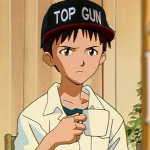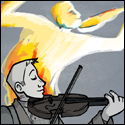frajaq posted:So how do you guys create humanoid enemies in campaigns? Like not the goblins/kobolds but humans/half-elves/dwarfs based on classes like paladins/rangers? Do you just take a look at the classes powers and simply them a bit? Generally speaking, PC powers have the wrong damage values for use against PCs, so it's easiest to just take monster powers from various sources and cobble them together if you're looking for something custom. On the other hand, there's seriously a shitload of humanoid monsters, even in just the MM3 plus the two Monster Vaults. You often just need to find a monster with roughly what you want, swap a racial power and you're good to go.
|
|
|
|
|

|
| # ? May 19, 2024 19:50 |
|
frajaq posted:So how do you guys create humanoid enemies in campaigns? Like not the goblins/kobolds but humans/half-elves/dwarfs based on classes like paladins/rangers? Do you just take a look at the classes powers and simply them a bit? You just build them like any other monster - AFAIK you can't/shouldn't build monsters like players because they operate by entirely different rules and math and scaling. EDIT: A couple of questions: 1. Combat Superiority is supposed to stop/cancel the move if the AOO hits. So, I use my Move Action to Shift one square, the Fighter takes an AOO at me, and then it hits, and then my Shift doesn't resolve because I got hit. I then trade my Standard Action down into a Move Action to try to Shift again. The Fighter gets another AOO, right? 2. What's the limit on reactions? 3. When "trading down" actions, Standard can turn into everything else, Move can turn into Minor and Free, and Minor can turn into Free? gradenko_2000 fucked around with this message at 06:49 on Apr 23, 2015 |
|
|
|
gradenko_2000 posted:1. Combat Superiority is supposed to stop/cancel the move if the AOO hits. So, I use my Move Action to Shift one square, the Fighter takes an AOO at me, and then it hits, and then my Shift doesn't resolve because I got hit. I then trade my Standard Action down into a Move Action to try to Shift again. The Fighter gets another AOO, right? So in your example, you shift, the fighter makes an MBA, and that's it - you've shifted away whether he hit or not (but he hits like a truck so you want to avoid that). But let's look at a few other ways this can play out. Remember, the MBA goes only against marked enemies, let's assume everyone here is marked. *You move away. The Fighter hits you with his OA, and your move stops. Now you shift away, but the Fighter attacks you with an MBA. *Again, you move, Fighter's OA stops you. You really want to get away, so you move again. Now the Fighter can't do a thing, he's used up his one OA for this turn. *Your ally does the above. You want to get away from the Fighter too, so you move, but he makes an OA because it's a new turn. *Your ally does the above again, and this time you shift, but now he can make an MBA against you. *Your ally shifts away from the Fighter and eats an MBA. Now you can safely shift away, because the Fighter has used up his Immediate action for this round (see below). But if you move instead, he can still make an OA. quote:2. What's the limit on reactions? quote:3. When "trading down" actions, Standard can turn into everything else, Move can turn into Minor and Free, and Minor can turn into Free? My Lovely Horse fucked around with this message at 12:32 on Apr 23, 2015 |
|
|
|
That's a pretty good explanation. Combat Challenge and Combat Superiority trip a lot of folks up. Nothing teaches you how Immediate and Opportunity actions work like playing a fighter. I honestly forgot you could immediate and opportunity in the same turn, but it's been ages since that's been relevant.
|
|
|
|
Echophonic posted:That's a pretty good explanation. Combat Challenge and Combat Superiority trip a lot of folks up. Nothing teaches you how Immediate and Opportunity actions work like playing a fighter. I honestly forgot you could immediate and opportunity in the same turn, but it's been ages since that's been relevant. It was pretty late in the game's development when I finally got around to playing a fighter. The fighter and the bard are two of the best things in 4e and those designers should be proud of themselves.
|
|
|
|
My Lovely Horse posted:words Okay, let me try that again: All characters have 1 Opportunity Action per turn. An Opportunity Attack is triggered by (among other things) Moving to become un-adjacent to a character, and this will consume the Opportunity Action. A Fighter's Combat Superiority class feature gives the OA an attack bonus equal to the Fighter's WIS, and causes OA hits to make the target stop moving. All characters have 1 Immediate Action per turn. A Fighter's Combat Challenge class feature allows the Fighter to make a Melee Basic Attack against a marked target whenever the marked target shifts, or whenever the marked target makes an attack that does not include the Fighter. The MBA granted by Combat Challenge consumes the Fighter's Immediate Action, which is different from an OA consuming the Fighter's Opportunity Action. The MBA granted by Combat Challenge does NOT get the WIS attack bonus nor the movement-stopping ability of Combat Superiority, since Combat Superiority applies specifically to OAs. In fact, since the MBA granted by Combat Challenge and OAs actually work on completely different triggers, it's actually very clear when one or the other applies. The former covers Shifts and attacks-not-including-the-Fighter on marked targets, while the latter covers Moving away, using a ranged attack while adjacent, and using an area attack while adjacent, so there's never any overlap. Did I get it that time?
|
|
|
|
Yep, that sounds right to me. From a Fighter perspective, Combat Superiority is +Wis to Opportunity Attacks that now end movement, Combat Challenge is your Immediate action mark punishment. Challenge and Superiority never overlap, they apply to totally different actions. You get one opportunity action per turn and one immediate action per round. This is the part that catches people, even in my group that's been playing for years. Echophonic fucked around with this message at 19:40 on Apr 23, 2015 |
|
|
|
gradenko_2000 posted:Did I get it that time? Mostly. You don't have to move to a non-adjacent square to provoke; Moving at all while next to something provokes an OA. Immediate Actions are per round. The only other bit of trivia regarding OAs/Interrupts/Reactions is that OAs have the same timing as Interrupts. There's also some niche things you can do to get OAs to have similar triggers as Combat Challenge (i.e. Champion of Order's level 11 feature) which would let you use both at once, but again, those are exceptions you'd have to set out to find/use.
|
|
|
|
Generic Octopus posted:Mostly. You don't have to move to a non-adjacent square to provoke; Moving at all while next to something provokes an OA.  ) That also tells you that any mode of movement can trigger the OA, except for shifting because it says so in the definition of shifting. ) That also tells you that any mode of movement can trigger the OA, except for shifting because it says so in the definition of shifting.Just for completeness' sake, forced movement (push, pull, slide) also doesn't provoke OAs (or trigger the Fighter's Combat Challenge). If your wizard is next to a nasty monster, someone can pull him away. And also: there are other opportunity actions besides attacks! If you come across those, they work like immediates, only on a per-turn basis: make an OA and you can't take any more opportunity actions this turn, and vice versa. Technically opportunity attacks are a subset of opportunity actions. Jesus. I'm starting to see where the "4E is too technical" folks are coming from. quote:Immediate Actions are per round. gradenko_2000 posted:never any overlap  I'm certain about half of the confusion could have been avoided if they hadn't given the two things such similar names.
|
|
|
|
My Lovely Horse posted:That also tells you that any mode of movement can trigger the OA, except for shifting because it says so in the definition of shifting. Also teleportation.
|
|
|
|
Generic Octopus posted:Also teleportation. Tbf, if there's a rule about movement, teleportation breaks it.
|
|
|
|
I always thought that immediate and opportunity actions were the same thing. How many offturn actions have I missed because I thought I only had one of them per round. Is there a general rule of thumb to differentiate between opportunity and immediate actions? Like immediate actions are used by powers and opportunity actions are opportunity attacks?
|
|
|
|
The rule is that powers that use your opportunity action say they're opportunity actions, and powers that use your immediate action say they're immediate interrupts/immediate reactions 
|
|
|
|
GimmickMan posted:I always thought that immediate and opportunity actions were the same thing. How many offturn actions have I missed because I thought I only had one of them per round. Most powers use immediate actions, and the most common opportunity action is the Opportunity Attack, but there's not really a hard rule to differentiate them besides the fact that one is per turn and the other per round. The powers themselves should tell you which they use though:  
|
|
|
|
I mean I was mostly trying to get out of rereading all of my options and committing the differences to memory but I guess this is going to make me reevaluate a bunch of them already so it is kind of moot. Thanks.
|
|
|
|
It really is a terribly clunky system when you stop and look at it. If I was designing a tactical combat system I'd have Opportunity Attacks and Immediate Interrupts at most. Actually I'd just give every class only one kind of off-turn action - Fighters get opportunity attacks, wizards get Shield, that sort of thing... DM: "The goblin runs past you." P1: "Well, then I make an opportunity attack." DM: "The goblin commander reacts to your opportunity attack with an attack of his own." P2: "I interrupt the commander's attack!" P3: "I grant P1 a bonus as a reaction to P2's interrupt!" DM: "Whose turn was it again?"
|
|
|
|
I've never seen anything like that happen, mostly because you can't use reactions on your turn. Monsters don't normally have those types of things blocked out, but anything that triggers off of someone else is a reaction or interrupt and shouldn't be happening on your turn.
|
|
|
|
Echophonic posted:I've never seen anything like that happen, mostly because you can't use reactions on your turn. Monsters don't normally have those types of things blocked out, but anything that triggers off of someone else is a reaction or interrupt and shouldn't be happening on your turn. That's not happening in Lovely Horse's example. Chains of reactions/interrupts can get confusing and tedious quickly.
|
|
|
|
Oh, I misread that P2 bit, my mistake.
|
|
|
|
I'd lie if I said it wasn't hyperbole, but also if I said the last line wasn't heard around our table more than once. Almost a bigger problem is when players take two or three different off-turn powers. Now in addition to planning their turn, they have to pay close attention to multiple triggers and, when they use one, keep track of which powers they can still use this round and when their immediate "recharges". I've got at least one player who specifically avoids anything to do with off-turn actions at all. Don't even get me started on players who miss their trigger and bring it up two turns later. "Hey, I actually could have done this, and Bob wouldn't have taken all that damage and the goblin would be over there, can we...?" - but that's where I draw the line. You could have, well you should have, but you didn't. It's not any easier when you DM and have monsters on the table with different off-turn powers - now you have to watch out for three different triggers while you're running the entire game. I've definitely forgotten to apply stuff that would have changed the course of a battle completely. (Fair is fair, obviously, I just ignored it, but still annoying.)
|
|
|
|
Interrupt chains are fun when they feel like you're playing a counterspell war in MtG. Too bad 4e doesn't have the robustness or even simplicity of MtG. 
|
|
|
|
Echophonic posted:That's a pretty good explanation. Combat Challenge and Combat Superiority trip a lot of folks up. Nothing teaches you how Immediate and Opportunity actions work like playing a fighter. I honestly forgot you could immediate and opportunity in the same turn, but it's been ages since that's been relevant. Try playing a Knight. The fact that your punishment is an OA really opens up the space to screw around with IA stuff normal fights wouldn't even consider. Warp In The Weave to punish bursts that would have included you is a personal favourite. Echophonic posted:I've never seen anything like that happen, mostly because you can't use reactions on your turn. Monsters don't normally have those types of things blocked out, but anything that triggers off of someone else is a reaction or interrupt and shouldn't be happening on your turn. thespaceinvader fucked around with this message at 09:38 on Apr 25, 2015 |
|
|
|
The funniest part about interrupt chains is trying to keep them all straight in your head; Sometimes they can drastically alter the effects of previous effects of the chain. It wasn't so bad before the developers started plopping At-Will interrupts into the mix, though. Before then it was usually just a huge flash-in-a-pan, once-an-encounter spectacular if it wasn't just a flat out once a day thing. Interrupts and off-turn actions in general are one major reason why combats take so long in 4E. They REALLY slow down a single round of combat if they're popping nearly every round. There's really no easy way to handle it, since I'll admit, interrupt chains are wicked fun for players to witness and as a GM I also like to see how crazy they can be. Over the course of my time as GM though, I've definitely subscribed to the idea of having fewer, but far more interesting, combats in 4E, so that's one way of handling it.
|
|
|
|
frajaq posted:So how do you guys create humanoid enemies in campaigns? Like not the goblins/kobolds but humans/half-elves/dwarfs based on classes like paladins/rangers? Do you just take a look at the classes powers and simply them a bit? I've done this rarely, because refluffing usually is enough, and there are many enemies that already mimic the mechanics of PC classes (particularly the classic D&D ones). I used to make generic enemies with roles according to the class roles I was trying to emulate - Defenders would be soldiers, controllers obviously controllers, leaders could be anything with a leader mechanic tacked on, and strikers could be lurkers, brutes, artillery or skirmishers. I'd usually give them one at-will power from the emulated class and plug in monster attack and damage values, which is probably the single most important thing you absolutely must do; maybe also an encounter power if the at-will alone didn't feel hefty enough. In retrospect that always involved a lot of second-guessing myself and usually too many effects to keep track of; these days I'd probably just try to figure out the one thing that makes a class identifiable and give that to a generic enemy. Fighters would have the marking and mark punishment, Rangers something like Twin Strike, Warlords get to grant allies attacks, Wizards get some controllery area attack, and so on. The rest is in the description. For that Avenger enemy I'm probably just going to transplant Oath of Enmity onto a generic monster wholesale and call it a day. That said, I always wondered how it would work out to make an NPC by NPC rules, give it powers from one class only, plug in monster HP/defense/attack/damage values, and use it as an Elite enemy. Might even give it a shot with this one. e: An at-will that lets you shift and slide an enemy with you, a utility power that lets you move half speed while phasing... this could be a pretty fun skirmisher. My Lovely Horse fucked around with this message at 17:30 on Apr 25, 2015 |
|
|
|
thespaceinvader posted:Try playing a Knight. The fact that your punishment is an OA really opens up the space to screw around with IA stuff normal fights wouldn't even consider. Warp In The Weave to punish bursts that would have included you is a personal favourite. That'd require me to play an essentials class, though.
|
|
|
|
Yes. Some of them are pretty fun.
|
|
|
|
I'm playing a level 1 Slayer in a gradenko_2000's PbP game, he does good damage but sometimes I feel the sting of not having a Daily power
|
|
|
|
Slayers start perking up at l3 when you can trade your second power strike for Rain of Blows, and get a LOT better at Paragon when you can trade your lame encounter power for Trip Up. MC Avenger, Ghost of the Past theme, Rending Gouge, Surprising Charge, Boots of the Mighty Charge. There's your daily power; it's a beast.
|
|
|
|
thespaceinvader posted:Slayers start perking up at l3 when you can trade your second power strike for Rain of Blows, and get a LOT better at Paragon when you can trade your lame encounter power for Trip Up. MC Avenger, Ghost of the Past theme, Rending Gouge, Surprising Charge, Boots of the Mighty Charge. There's your daily power; it's a beast. You mean I can steal broken multiclass options and take a charge kit/gouge like literally everyone else with any system mastery? How fulfilling. More often than not, the actual utility of an Essentials class is poaching its abilities in whatever way for actually good/fun classes. By the way, my group is playing an epic campaign in 4E right now and we are playing despite everyone at the table agreeing that the combat is completely stupid at this level of play, it loses just about everything that makes 4E good and the options they provide are few and usually very low-effort compared to paragon tier, which is much more varied and robust. Depending on the class, you even get problems with powers that aren't as good as the stuff you picked up 10-20 levels ago.
|
|
|
|
Yes, but *better*. Alternatively, no, there's nothing broken about any of what I described. It's powerful, but by no means broken, with the sole possible exception of the Rending Gouge (which I choose to self-limit to be unable to proc its own attack, but still to work as intended as not limited by the free-action-attack rule, which was not well-written in the first place). You snark; I like playing optimised, simple characters. I like my Slayer, I like my Knight, because they allow me to focus on the part of the combat I enjoy in 4e, which is the tactical positioning and strategy, rather than the 'what-power-to-use' game. Also, that unlike certain classes, at higher levels they still engage with the game rather than going out of their way to defeat it. Epic combat is hella crazy. We've played through epic LFR twice now, and had little trouble either time, but in completely different ways. One group outlasts the fights, the other controls them into oblivion and/or annihilates them before the third turn (not round, turn) of combat. A bunch of guys with good initiative and massive action enabling, versus a bunch with strong interrupts and good toughness. It's interesting as an academic exercise, but I really feel the pinch playing a Knight who engages with the game, when there are two Wizards on the board who almost entirely invalidate the combats full stop because all the things are stunned before they act anyway, then dead before they act again, and who shout at me when I pull tricks to move groups of enemies on to me, and take them out of other bursts instead. E: and yeah, the issue with early-level powers being retained is definitely a thing. It's a design issue with Psionic classes, but still an issue with some non-psionics, especially Rangers, Disruptive Strike being the ur-example, though Avengers have similar issues with Fury's Advance. thespaceinvader fucked around with this message at 22:27 on Apr 25, 2015 |
|
|
|
thespaceinvader posted:Yes, but *better*. Alternatively, no, there's nothing broken about any of what I described. It's powerful, but by no means broken, with the sole possible exception of the Rending Gouge (which I choose to self-limit to be unable to proc its own attack, but still to work as intended as not limited by the free-action-attack rule, which was not well-written in the first place). I generally find that the easiest way to win (if you are not counting on coordinating closely with other players in character creation) is to buff out initiative and NADs and then take powers that grant the group free attacks. My DM has a weird thing where every loving fight involves monsters that attack Reflex and ignore marks one way or another, so I quickly got fed up trying to be a defender or really anything that isn't some form of striker, even if it's by proxy (warlord/bard). If I hadn't thought to bring a Feyslaughter weapon first session I doubt I would've effectively marked anything for the first month of play. Heavy control generally results in a group where you're barely even spending healing surges and don't really need a leader.
|
|
|
|
It does - but the trouble is that when you get those few mobs that do shed control or have really nasty auras, autodamage, etc... you become quite unsafe.
|
|
|
|
My Lovely Horse posted:I'd usually give them one at-will power from the emulated class and plug in monster attack and damage values, which is probably the single most important thing you absolutely must do Yeah when I was very early in my 4e career I just stated up an enemy cleric using the NPC rules to support a dragon because I was a god drat idiot and she got pasted in like two attacks from, I think, the party cleric because Holy War. I love the idea of interrupt chains because I want to either recreate the like seven hit parry-counterparry chains from MGR or have an excuse to go all
|
|
|
|
I find interrupts a lot more difficult to track with monsters, because they usually wind up slap bang in the middle of a multi-attack power and I usually just say 'add it all up ad give me the damage at the end', forgetting that 'at the end' will mean it was bloodied two hits ago etc etc etc. Plus, it's a lot easier to pay attention to what you've got to use, when it doesn't change every fight.
|
|
|
|
My Lovely Horse posted:That said, I always wondered how it would work out to make an NPC by NPC rules, give it powers from one class only, plug in monster HP/defense/attack/damage values, and use it as an Elite enemy. Might even give it a shot with this one. Level 5 Skirmisher Defenses and HP in line with MM3 math Standard Actions At-Will Melee, +10 vs. AC, 13 damage (crit 18); shift 1 and slide the target into vacated space Encounter Effect: Shift half speed (3), gain phasing for this movement, then: Melee, +10 vs. AC, 18 (28) damage Move Actions Encounter Effect: Become invisible, move your speed (6), become visible again Minor Actions Special Just like Oath of Enmity; designate one enemy as Oath Target and roll 2d20 for attacks against him when no other enemies are adjacent, lasts until the end of the encounter or until the enemy is down. Workable? e: going over my prepwork for this weekend, I realized that I didn't do XP budgets of [same level monster] x [number of PCs], but for some reason [same level monster] x 10. That could have gone badly. "Wonder why this fight is taking so long ooooooh." My Lovely Horse fucked around with this message at 07:02 on Apr 28, 2015 |
|
|
|
So, I'm a relatively new 4e GM, but I've been hanging around the thread for a while. My group has just finished the first book of War of the Burning Sky, and they've liked it quite a bit so far. Potential spoilers for WotBS, if you plan to play it. One of my players is a Shahalesti bard whose family was taken from him during the last Ragesian seige on Gate-Pass, so watching him deal with Inquisitors, fellow Eladrin, and the wizard who's dominating his family to their demise has been a lot of fun. I really like that despite the length of time spent in the city, the book has really had something to offer all of my players: Dwarven cities and relics, Eladrin spies, Wizard schools, thieve's guilds, mercenaries, etc. However it has been a bit of a railroad for the players and now that they're out of the city, I wanted for them to be free to explore some of their personal motivations, but the next book seems like a long, 3 level railroad through the Fire Forest for what was set up to be a short but challenging locale. If anyone has run WotBS before, do you have any tips on minimizing the content in the Fire Forest? As for gameplay issues, I've been handing out magic items according to the specifications in the GM guide, and I have to say that managing items takes up more of my time than I would like on the GM side. Some of my players love to shop and have wishlisted items out to 10th level, but others really can't be bothered with it. I don't want to ditch magic items but it's pretty cumbersome. Also, even with MM3 math some players get discouraged at the defenses of certain enemies. This is partially because one of them only has attacks versus reflex and if an enemy has a particularly high reflex, he feels cheated. To combat this, last session I started using 13th Age's escalation die. I'm worried that in 4th edition, this might trivialize combat though, which I'd like to avoid because 4e's specialty is being a combat engine. For encounters that haven't suffered defense problems, my group generally kills big bads in a couple rounds which makes them seem not so big and bad. I'd really like to get to use more of their monster abilities, but combat is already pretty long in terms of time at the table. Is the answer larger health pools? I've found that more groups of weaker enemies makes for more engaging combats, so I've started increasing the number minions and lesser enemies. I guess I'm wondering if anyone has any advice on creating more engaging, but not longer encounters.
|
|
|
|
Vel posted:As for gameplay issues, I've been handing out magic items according to the specifications in the GM guide, and I have to say that managing items takes up more of my time than I would like on the GM side. Some of my players love to shop and have wishlisted items out to 10th level, but others really can't be bothered with it. As for managing items, the Rules Compendium had a distribution method where you roll randomly. You can easily use that and simply roll on the players' wish lists. quote:This is partially because one of them only has attacks versus reflex and if an enemy has a particularly high reflex, he feels cheated. To combat this, last session I started using 13th Age's escalation die. I'm worried that in 4th edition, this might trivialize combat though, which I'd like to avoid because 4e's specialty is being a combat engine. e: my players, for example, like to hoard their daily powers and action points - I'm sure they would put off using them even longer if there was an element of "if I wait until next turn I'll have a better chance to hit." quote:Is the answer larger health pools? quote:I've found that more groups of weaker enemies makes for more engaging combats, so I've started increasing the number minions and lesser enemies. I guess I'm wondering if anyone has any advice on creating more engaging, but not longer encounters. Try replacing one enemy with a skill challenge of lowest complexity (4 successes before 3 failures). That might very well be a trap, which are best used as part of combat anyway. Gives players something to do besides just optimizing their combat moves, and every so often it could even be the deciding factor of the combat to begin with. Alternative combat goals besides "kill everyone" are also neat. Protect the NPC, occupy key squares on the battlemap to throw switches at the same time, survive for X rounds against an endless onslaught... My Lovely Horse fucked around with this message at 22:25 on Apr 28, 2015 |
|
|
|
My Lovely Horse posted:More but weaker enemies is the way to go. 2-hit minions 
|
|
|
|
Strike has normal minions, as well as stronger minions that die in two hits or if they take a single hit that exceeds a certain amount of damage. That sounds like a monster type worth stealing for 4e.
|
|
|
|

|
| # ? May 19, 2024 19:50 |
|
Gort posted:Strike has normal minions, as well as stronger minions that die in two hits or if they take a single hit that exceeds a certain amount of damage. That sounds like a monster type worth stealing for 4e. Almost everyone running 4e has been using them already.  I set the threshold at 5/10/15 + half level so strikers usually drop them in 1 at-will.
|
|
|




























